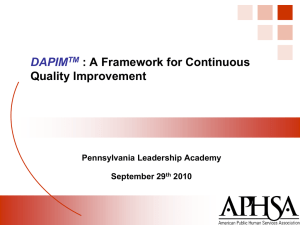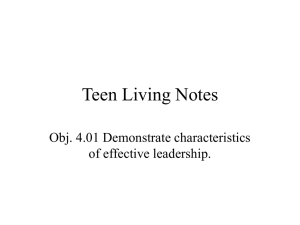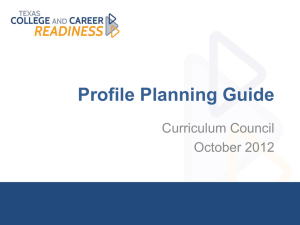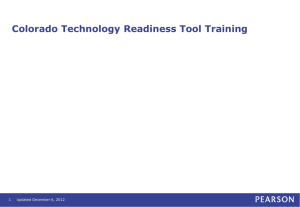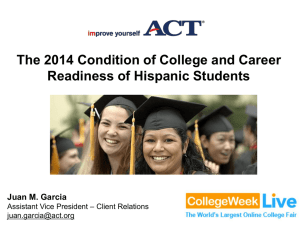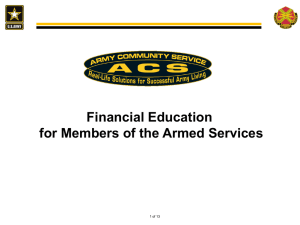Readiness Matters - College Changes Everything
advertisement
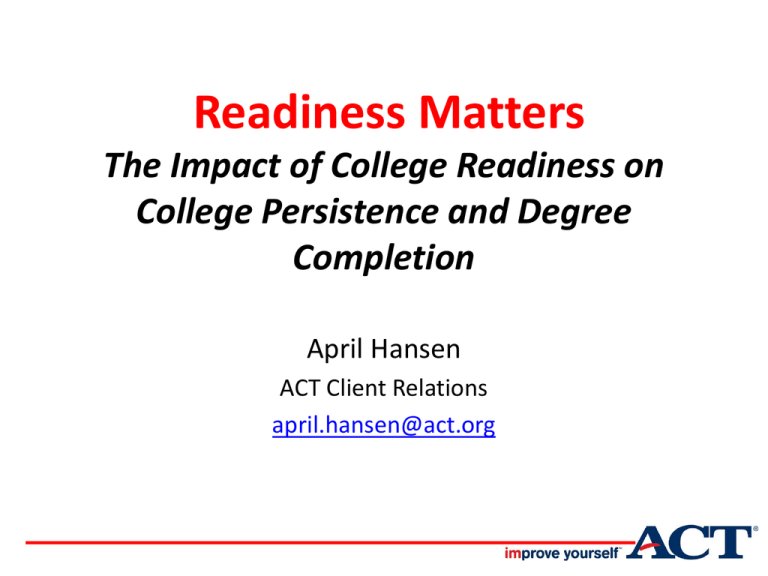
Readiness Matters The Impact of College Readiness on College Persistence and Degree Completion April Hansen ACT Client Relations april.hansen@act.org ACT’s Unique Vantage Point • The ACT Assessment began in 1959 to assess what students have already learned and are ready to learn next to be college and career ready. • 52% of the 2012 HS graduating class took the ACT: 1.66 million students • 146,822 in Illinois • ACT Explore (grade 8 & 9), ACT Plan (grade 10), and the ACT (grade 11 & 12) form longitudinal assessment system that can provide academic interventions and shape curriculum to keep students on track • Assessments of academic behaviors, psychosocial factors How do we define College and Career Ready? The level of preparation a student needs to be ready to enroll and succeed in—without remediation—a first-year, credit-bearing course at two- or four-year institutions or in trade or technical schools. Adopted by the Common Core State Standards Initiative College Readiness Benchmark Attainment • Empirically derived minimum scores needed on an ACT subject-area test to indicate a 50% chance of obtaining a B or higher or a 75% chance of obtaining a C or higher in the corresponding first-year credit-bearing college course. College Course EXPLORE Grade 8 EXPLORE Grade 9 PLAN Grade 10 ACT Compass English Composition 13 14 15 18 77 Math College Algebra 17 18 19 22 52 Reading Social Science 15 16 17 21 88 Science Biology 20 20 21 24 NA Test English Students who are college/career ready when they leave high school have a significantly higher likelihood of: Enrolling in college the fall following high school graduation Persisting to a second year at the same institution Earning a grade of B or higher in first-year college courses Earning a first-year college GPA of 3.0 or higher Not needing to take a remedial courses Graduating within 150% of time Entering the job market with significantly higher lifetime earning potential. Regardless of ethnicity and SES % who graduate from public high schools: % who immediately go on to college: 76% 57% % of 9th graders who graduate from high school on time, go directly to college, return for their 2nd year, and graduate within 150% of program time: 20% NCHEMS. (2011) Key Finding 1 Being better prepared academically for college improves a student’s chances of completing a college degree. Benchmarks matter. College Success by Number of ACT Benchmarks Met College Success by ACT Score/Benchmark Attainment • 53% enrolled in a 4-year college (80% of the students meeting all 4 CRBs enrolled in a 4 year college) • 18% enrolled in a 2-year college (6% of students meeting all 4 CRBs enrolled in a 2-year college) • 29% did not enroll in college (43% of the 0-1 group didn’t go to college at all) College Success by ACT Score/Benchmark Attainment • Across all outcomes, – College success rates increased as ACT Composite score increased. – Students who met the ACT College Readiness Benchmarks had higher success rates than those who didn’t. – The more Benchmarks students met, the higher the success rates. Coursework Matters • Core curriculum taken vs. not taken (4-3-3-3). • HS mathematics coursework taken: – Less than (<) Algebra I, Geometry, Algebra II. – Algebra I, Geometry, Algebra II. – More than (>) Algebra I, Geometry, Algebra II. • HS science coursework taken – Biology – Biology, Chemistry – Biology, Chemistry, Physics 2012 Avg. ACT Composite Scores by Type of Coursework and Race/Ethnicity Average ACT Score Race/Ethnicity Number Tested % Taking Minimum Core or More Minimum Core or More Less than Core All Students 146,882 56% 22.5 19.0 African American 20,978 48% 18 16.5 382 45% 20.1 17.5 Caucasian/White 75,985 62% 24.1 20.5 Hispanic/Latino 26,434 48% 19.9 17.4 Asian 5,776 73% 25.2 21.7 377 60% 21.9 19.8 Two or more races 3,973 58% 22.8 19.7 No Response 12,917 43% 22.1 18.4 American Indian/ Alaska Native Native Hawaiian/ Other Pac. Isl. "Core or More" results correspond to students taking four or more years of English and three or more years each of math, social studies, and natural science. College Enrollment/Retention Rates Math Course Sequence Enrolled in college first year Less than Alg 1, Geom, Alg II Re-enrolled in college second year Alg 1, Geom, Alg II Alg 1, Geom, Alg II, Other Adv Math Alg 1, Geom, Alg II Other Adv Math, Trig Alg 1, Geom, Alg II, Other Adv Math, Trig, Calc As the rigor of math courses increases, the chances of college enrollment/persistence also increase. College Enrollment/Retention Rates Science Course Sequence Enrolled in college first year Re-enrolled in college second year Biology Biology and Chemistry Biology, Chemistry, and Physics As the rigor of science courses increases, the chances of college enrollment/persistence also increase. Key Finding 2 Using multiple measures of college readiness better informs the likelihood of a student persisting and succeeding in college. College Success by HS GPA and HS Coursework • Across all outcomes, – Students with HSGPAs ≥ 3.50 had higher success rates than those who had lower HSGPAs. – Students who took the HS core curriculum had slightly higher rates than those who didn’t. – Students who took higher-level mathematics or science courses had higher rates than those who took fewer courses. Degree Completion by HS GPA and ACT Scores Academic Achievement and Academic Behaviors Key Finding 3 College readiness reduces gaps in college going rates, persistence and degree completion among racial/ethnic and family income groups. College Success by Race/Ethnicity and Number of ACT Benchmarks Met College Success by Family Income and Number of ACT Benchmarks Met Reductions in Racial/Ethnic Gaps in College Enrollment Associated with Meeting All Four ACT College Readiness Benchmarks Enrolled in college first year White Underrepresented minorities 75 All 61 College ready in 4 subjects 14 84 78 6 Gap reduction: 8 percentage points Reductions in Racial/Ethnic Gaps in College Retention Rates Associated with Meeting All Four ACT College Readiness Benchmarks Re-enrolled in college second year White Underrepresented minorities All 74 68 6 College ready in 4 subjects 84 83 1 Gap reduction: 5 percentage points Reductions in Family Income Gaps in College Enrollment Rates Associated with Meeting All Four ACT College Readiness Benchmarks Enrolled in college first year Highest family income group Lowest family income group 82 All 58 College ready in 4 subjects 24 85 77 8 Gap reduction: 16 percentage points Reductions in Family Income Gaps in College Retention Rates Associated with Meeting All Four ACT College Readiness Benchmarks Re-enrolled in college second year Highest family income group Lowest family income group 79 All 66 College ready in 4 subjects 13 86 78 8 Gap reduction: 5 percentage points Reductions in Racial/Ethnic Gaps in 4-Year College Degree Completion Rates Associated with Meeting All Four ACT College Readiness Benchmarks Graduated from college in 4 years White Underrepresented minorities 39 All 26 College ready in 4 subjects 13 86 78 8 Gap reduction: 5 percentage points Key Finding 4 Early monitoring of readiness is associated with increased college success. Catching up to College Readiness “…the level of academic achievement that students attain by eighth grade has a larger impact on their college and career readiness by the time they graduate from high school than anything that happens academically in high school” --The Forgotten Middle, p.2 Findings of “Catching Up” Study • Few Far Off Track students catch up in middle or high school. • Even in higher performing schools, the majority do not get on track to college and career readiness in four years. • There are lots of Far Off Track students by this definition – for example, 40-50% of minority students… • …and they have a low probability of hitting the Benchmark in four years. College Success by Readiness Indicators in Grades 8, 10, and 11/12 • Early readiness indicators are predictive of college success. • Early and sustained college readiness in high school is associated with persisting to degree completion. – Students who were on target early in grades 8 and 10 for becoming college and career ready and then graduated from high school college and career ready had the highest college success rates. – Students who were not on target in grades 8, 10, and 11/12 had the lowest success rates. College Readiness Benchmark Attainment • Empirically derived minimum scores needed on an ACT subject-area test to indicate a 50% chance of obtaining a B or higher or a 75% chance of obtaining a C or higher in the corresponding first-year credit-bearing college course. College Course EXPLORE Grade 8 EXPLORE Grade 9 PLAN Grade 10 ACT Compass English Composition 13 14 15 18 77 Math College Algebra 17 18 19 22 52 Reading Social Science 15 16 17 21 88 Science Biology 20 20 21 24 NA Test English Readiness Matters Key Findings • Being better prepared academically for college improves a student’s chances of completing a college degree. • Using multiple measures of college readiness better informs the likelihood of a student persisting and succeeding in college. • College readiness reduces gaps in persistence and degree completion among racial/ethnic and family income groups. • Early monitoring of readiness is associated with increased college success. Questions/Comments April Hansen ACT – Client Relations Account Executive april.hansen@act.org

